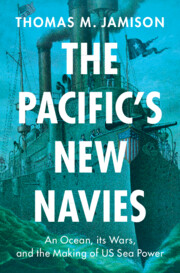Book contents
- The Pacific’s New Navies
- Military, War, and society In Modern American History
- The Pacific’s New Navies
- Copyright page
- Dedication
- Contents
- Figures and Table
- Acknowledgments
- Introduction
- 1 The Confederate “Navy to Construct”
- 2 The Pacific’s Civil War Inheritance
- 3 Pacific Naval Races and the Old Steam Navy
- 4 Pacific Wars and Their Lessons
- 5 The Californian Case for a New Navy
- 6 The US New Navy Wins a Race – Finally
- 7 The Sino-Japanese War and New “Yankees” in the Pacific
- Conclusion
- Notes
- Bibliography
- Index
5 - The Californian Case for a New Navy
Published online by Cambridge University Press: 05 December 2024
- The Pacific’s New Navies
- Military, War, and society In Modern American History
- The Pacific’s New Navies
- Copyright page
- Dedication
- Contents
- Figures and Table
- Acknowledgments
- Introduction
- 1 The Confederate “Navy to Construct”
- 2 The Pacific’s Civil War Inheritance
- 3 Pacific Naval Races and the Old Steam Navy
- 4 Pacific Wars and Their Lessons
- 5 The Californian Case for a New Navy
- 6 The US New Navy Wins a Race – Finally
- 7 The Sino-Japanese War and New “Yankees” in the Pacific
- Conclusion
- Notes
- Bibliography
- Index
Summary
When refracted through California, the story of US naval expansion in the 1880s – the creation of a small but respectable force of steel cruisers and gunboats – becomes a form of naval racing against Pacific newly made navies. Californians and their national allies argued for a New Navy, citing fears of Chile, China, and eventually Japan. These fears were not only material, stemming from the technical inferiority of the US Old Navy, but also cultural, as naval programs in the Pacific threatened assumptions about US racial and civilizational superiority. Physically, advanced navies in the Pacific stoked fear in Californian cities about raids from the sea. Technologically, Pacific newly made navies (and especially the Chilean cruiser Esmeralda) served as yardsticks to measure US Navy progress. Culturally, the sophistication of Pacific navies undermined beliefs about the position of the United States as the most advanced nation in the hemisphere. These threats allowed navalists to make an effective argument for funding a small, cruiser-dominated New Navy in the 1880s that could in the near term compete with its Pacific rivals.
- Type
- Chapter
- Information
- The Pacific's New NaviesAn Ocean, its Wars, and the Making of US Sea Power, pp. 104 - 126Publisher: Cambridge University PressPrint publication year: 2024

